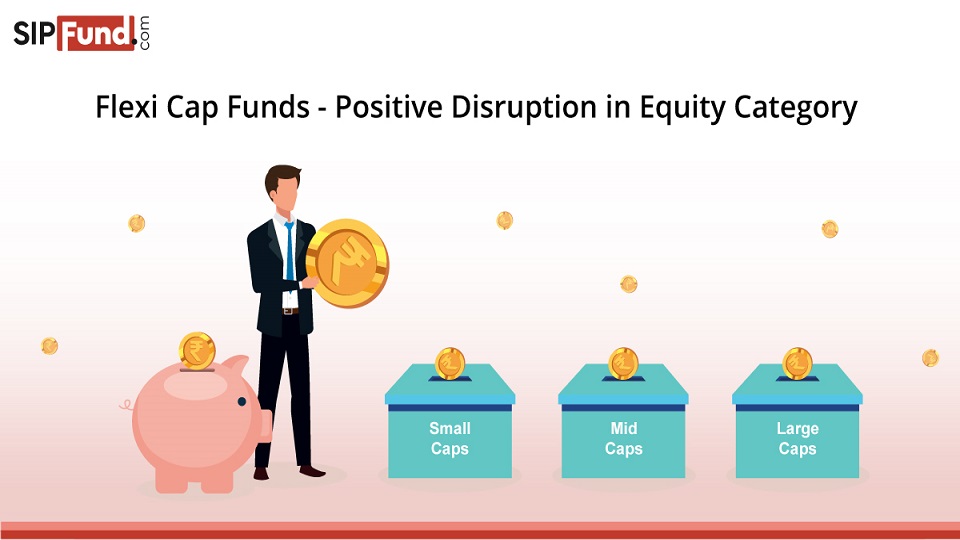
Flexi Cap Funds – positive disruption in equity category
SEBI has come up with a new category of equity mutual funds called “Flexi Cap”. As per SEBI, these funds are required to invest at least 65% of total assets in equity and equity related assets. Fund will be invested across large-cap, mid- cap and small- cap stocks. Asset management companies (AMCs) can convert the existing scheme into a flexi-cap fund.
There are already ample of categories available in the mutual fund domain. Why did SEBI introduce another one?
On 11th September 2020, SEBI came up with the directive which mandates the Multi Cap funds to invest a minimum 25% of their 75% equity corpus each in large-cap, mid- cap and small cap funds. This step was taken to make Multi Cap funds more diversified and avoid the concentration of wealth in any one category as they were not operating to what SEBI called “true to label”. However, fund houses felt that this rule has curtailed their flexibility. This move has also led to huge inflow into Small Cap funds as funds must maintain 25% rule and their earlier portfolio was consisting a larger corpus in Large Cap funds. Multi Cap schemes with AUM of approximately INR 1.5 trillion are very popular in markets therefore it was not a prudent step to shake it with Multi Cap restrictions. Some fund managers felt restricted by this rule and they voiced their concern to SEBI for relaxing the limits. SEBI responded with a new category of Flexi Cap funds. Let us understand this category in detail:
What are “Flexi cap” mutual funds?
Flexi Cap mutual funds as the name suggests, are those funds which invest in stocks across the market capitalization spectrum – Large Caps, Mid-Caps and Small Caps. This action was taken by SEBI in consultation with Association of mutual Funds in India (AMFI). Flexi Cap funds will allow the fund managers to invest freely across market caps. They can also convert the existing schemes into flexi cap schemes easily. If fund managers want to see the existing mutual fund schemes in Flexi Cap category, then they just require renaming it to Flexi Cap and everything else will remain same. Existing investors can now take the advantage of this new category by converting their portfolios into Flexi Cap category. Multi Cap funds like Parag Parikh Long Term Equity, Kotak Standard Multi Cap and Motilal Oswal Multicap 35 Fund have already moved into this new basket as they will not be restricted to market cap after registering as Flexi Cap funds. Except the few changes in fundamentals, everything else will remain same.
How will it benefit the investors?
This new category will work as cherry on the cake for investors who want high degree of freedom to invest across all kind of market capitalization stocks. It can help to achieve stability for retail investors as they can increase or decrease their inflows across the market caps as per their financial goals. Investor have been given a 30 –day window to convert their schemes into Flexi Cap schemes without paying any exit load. It is suggested that investors should be in vigilance mode till January 31st in order to track the changes in Flexi Cap funds. If it is noted that alterations are just in the domain of changing name of the scheme, then you can stick to the fund as fund manager may increase their exposure to Large Cap funds initially. Once the economic conditions get better fund houses may then increase their exposures into Mid Cap and Small Cap stocks. Existing investors reclassifying into Flexi Cap category are not subject to taxation although it will be considered as a redemption. This process of redemption will attract capital gain taxes as applicable. Having said that investors are advised to ascertain whether this new Flexi Cap category will serve the overall purpose in meeting the financial objectives or they are better in existing category.
The dilemma
Multi Cap funds with new directives as on 11th September 2020 has no past records on which the decision can be made to whether settle with Flexi Cap or remain in Multi Cap category. Taking a note of prolonged economic slowdown, hopes for Small Cap and Mid Cap are gloomy. Additionally, some companies in Mid and Small Cap spaces are tarred with corporate governance issues and they have stability issues as well. Fund managers therefore find it difficult to choose stocks from this space very challenging. Some mutual fund experts are of the opinion that Flexi Cap funds will probably hold more of Large Cap stocks in coming months and when rally turns in favor of Small Cap and Mid Cap, they can increase their allocation to these segments. However, a new wave of Small Cap funds is being seen currently as SBI and UTI has come up with Small Cap NFOs.
Conclusion
Introduction of flexi-cap category by SEBI has worked as a relief to both fund houses and investors. Fund houses are content now as they don’t have to incur much cost and spend time as they are just supposed to change the name of the scheme while reclassifying into Flexi Cap. Investors are happy as they can stay invested in existing schemes or can flexibly invest across the market capitalization. If Multi Cap funds were part of your mutual fund portfolio, then there is not much to do for you. However, investors are advised to keep an eye on all announcements related to Multi Cap funds over the coming months. It would be wise to have a word with your financial advisor or distributor to comprehend all the details in order to decide the suitability of Flexi Cap Funds to your financial goals.
Happy Investing!

